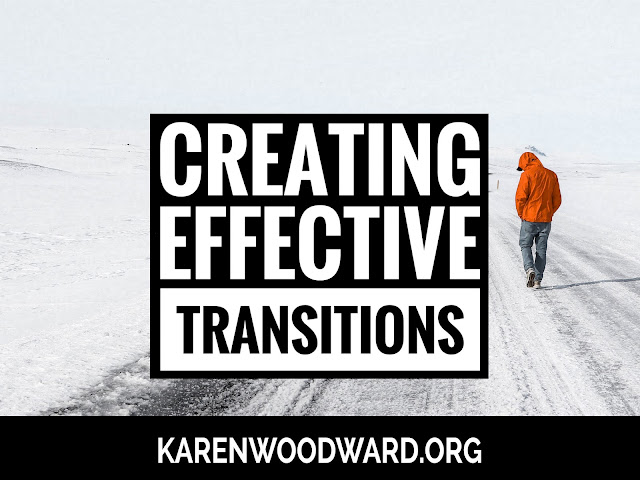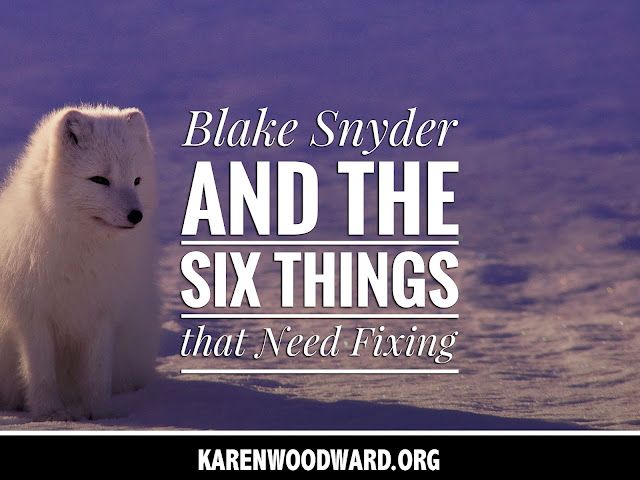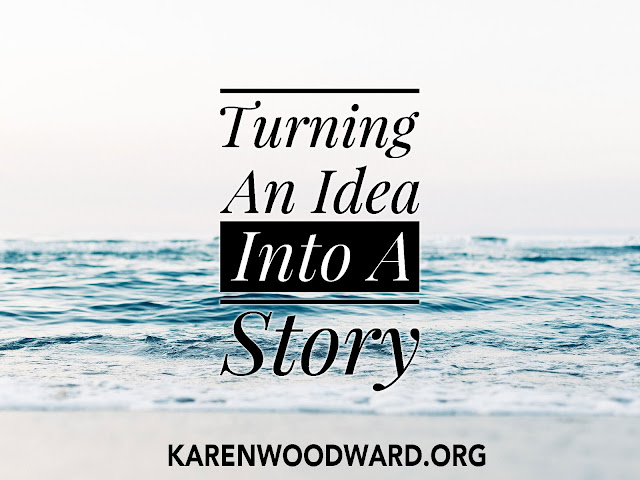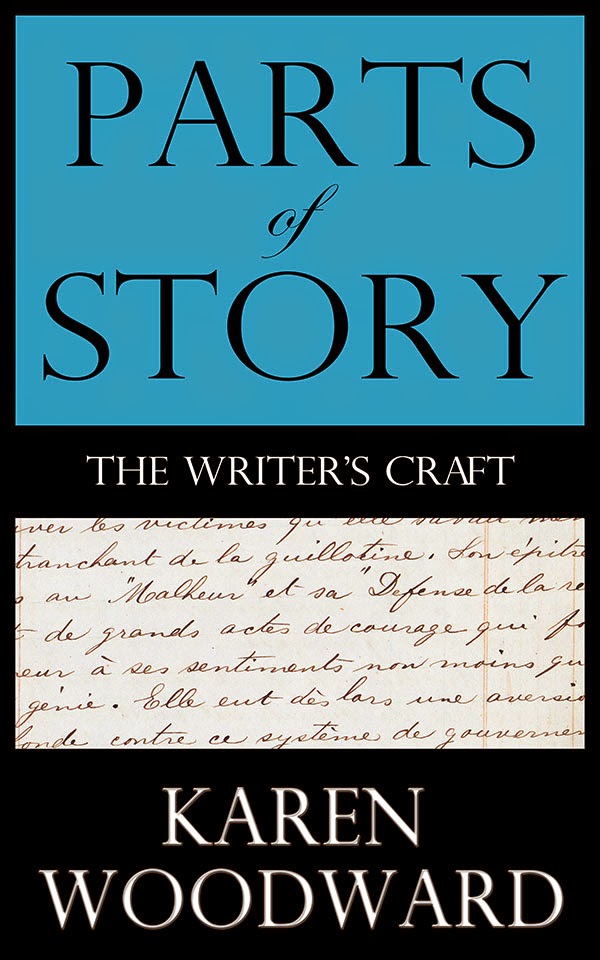Transitions are tricky. In a scene you write in the moment, recording your character's thoughts, feelings, actions and—most important of all—desires. In those times when you're immersed in the scene writing can seem effortless.
Transitions, not so much.
I'm not saying it's unclear what I need to do in a transition. At least, speaking generally. I know where I need to start (the disaster that ended the previous scene) and where I need to end (the viewpoint character's new goal) and what I need to do in between these two points (emotion --> thought --> decision --> action). But, still, these are general guidelines that allow for a LOT of flexibility.
Today I'm going to talk about how to create effective transitions between scenes.
(BTW, if you’re wondering what a sequel is I talk about them in Scenes, Sequels, Sequences and Acts. For more about scenes and sequels I also recommend Dwight V. Swain's book, Techniques of the Selling Writer and Jack Bickham's Scene & Structure.)
Simple Transitions and Sequels
Jack Bickham tells us there are two kinds of transitions: simple transitions and sequels.
I talk more about simple transitions, below, but basically simple transitions are what they sound like, one or two lines that takes you from one place/time to another place/time. For example, "At 10:30 Sarah was eating ice cream, three hours later she was dead."
Sequels are longer more complex transitions that link scenes together. At the beginning of a sequel the protagonist has been humiliated and defeated. Not only has he NOT achieved his goal, he has lost whatever progress he made. The question is: What does he do now? What is his next goal?
Transitions are about emotion.
All transitions should show the viewpoint character's emotion. (Scenes, on the other hand, are about CONFLICT.) Dwight V. Swain in Techniques of the Selling Writer states that emotion “unifies sequel and holds it together.”
During a sequel your protagonist is preoccupied with the emotional and physical aftermath of whatever disaster ended the previous sequel. Swain writes that for a character to be preoccupied in this way is “actually to be preoccupied with a particular set of feelings. If your girl runs out on you ... you feel hurt and angry. If your boss fires you, you feel angry and panicky. If your friend betrays you, you feel grieved and confused.”
“... until you decide what to do about the situation, your feelings can’t help but be the thing uppermost in your mind.”
In a transition you summarize, skipping anything that doesn't help communicate the viewpoint character's dominant emotion, that doesn't help show his or her reaction to the disaster at the end of the preceding scene.
The Dominant Feeling
Let's talk a bit more about that last point. Think about the particular transition you’re writing. What is your character’s dominant feeling? Is it hate? Love? Fear? Desperation? Dread? Whatever it is, this will give you the unifying theme. For example:
Lily blinked at her computer and cringed. She would rather have a root canal than try to string words together coherently. Perhaps her ideas would flow more easily tomorrow. But when tomorrow came even the thought of writing felt like the blade of a knife.
In the above example I attempted to communicate the feeling of dread I've felt a time or three at the prospect of having to commit words to (virtual) paper. Lily was also dying for a big juicy hamburger and tired after a night of troubled sleep, but I didn't say anything about that because it wouldn't help express her feeling of dread.
Simple Transitions
Let's take a deeper look at simple transitions. As Jack Bickham writes in Scene & Structure, simple transitions cover either a change in time, a change in place or a change in viewpoint.
a. A change in time
Example: “It was the following Tuesday when they met again.”[1]
Example: Ruth flung her head back, closed her eyes and faced the sun, letting the heat dance over her skin. She wanted it to stay sunny forever. Alas, she lived in the Pacific Northwest. Fifteen minutes later it started to rain.
Transitions generally come between scenes and compress time. Chances are the protagonist has lost and lost big at the end of the previous scene. She must now figure out what to do and, as part of this, she will likely need to travel to different places, talk to different people. If we followed our protagonist around second-by-second our story would be very boring. So we need to summarize, condense. We need to figure out her dominant emotion and let that guide our choices.
b. A change in place
Example: “At about the same time Joe met Billy another meeting was taking place on the other side of town.”[1]
Just as transitions compress time they generally compress space as well. When your protagonist goes to visit his friends you're not going to want to describe the car, the heat, etc. You only want to bring in what’s important for your story.
c. A change in viewpoint
Example: Dan smiled hoping his girlfriend, Jan, wouldn’t find out he’d made it to second base with her best friend. [New chapter] “Bastard!” Jan thought, looking at Dan, seeing his guilty smile.
Changes in viewpoint are straightforward. First you were telling the story through one character's eyes and now you've switched and are telling the story through another character's eyes.
Just make sure it's clear to the reader that the viewpoint has changed as well as whose viewpoint the story is now being told from. The writer doesn't want to confuse the reader so it's a good idea to do this in the first sentence and certainly in the first paragraph.
Transitions and Time
Recall that scenes happen in the moment, time unfolds second after second. Sure, time can slow down but there are no jumps, no gaps.
But if you wrote a story that detailed every single second of your protagonist's life you'd end up with a story bored any reader to tears!
We need to see characters live moment-by-moment when there is a burst of purposeful activity (i.e., a scene) but then we need to transition to the next burst. How we do this greatly affects the pace of a story.
Controlling Pace
New writers tend to write stories that need speeding up rather than slowing down, but here are the a few pointers for doing both. (Most of these points were drawn from Jack Bickham's book.)
How to speed up the pace of a story:
- Where possible, remove sequels from between scenes.
- Where it’s not possible to remove a sequel see if it would be just as effective if you used a simple transition rather than a sequel.
- Can you cut some descriptions of emotion from your sequels?
- Check the motivations and goals of your characters in the scenes your transition links. Is it clear what motives your main characters? What their goals are?
- Can you raise the stakes in one or more of the scenes?
- Can you make the disasters at the end of your scenes more dramatic?
How to slow down the pace of the story:
- Cut one or more scenes.
- Shorten one or more scenes.
- Reveal more of the viewpoint character’s thoughts.
- Expand the sequels.
That's it for today! I'll talk to you again on Friday. Till then, good writing!
Every post I pick something I believe in and recommend it. This serves two purposes. I want to share what I like with you, and, if you click the link and buy anything over at Amazon within the next 24 hours, they put a few cents in my tip jar at no cost to you. So, if you click the link, thank you! If not, that’s okay too. I’m thrilled and honored you’ve visited my blog and read my post.
I've talked about Jack Bickham and Dwight V. Swain in my article and can wholeheartedly recommend their books. Yes, they say basically the same thing but I love reading authors who the same topic but from different perspectives. If you're wondering which book to start with I'd recommend Jack Bickham's Scene & Structure.
Here's a quote from Scene & Structure:
MENTION WORDS SUCH AS STRUCTURE, form, or plot to some fiction writers, and they blanch. Such folks tend to believe that this kind of terminology means writing by some type of formula or predetermined format as rigid as a paint-by-numbers portrait.
Nothing could be further from the truth.
In reality, a thorough understanding and use of fiction’s classic structural patterns frees the writer from having to worry about the wrong things, and allows her to concentrate her imagination on characters and events
Note:
1. The example for (a) and (b) were from Jack M. Bickham’s book, Scene & Structure.









